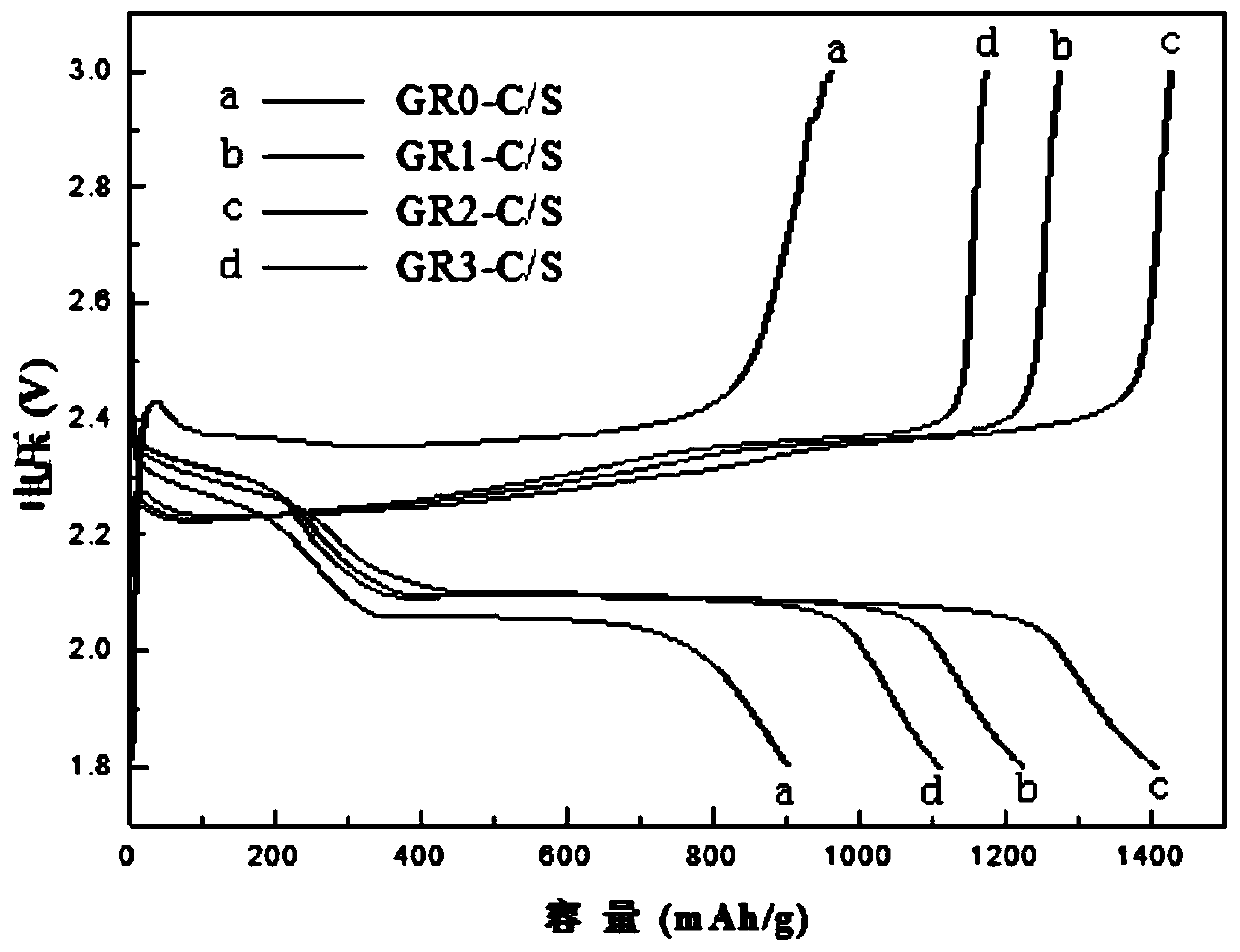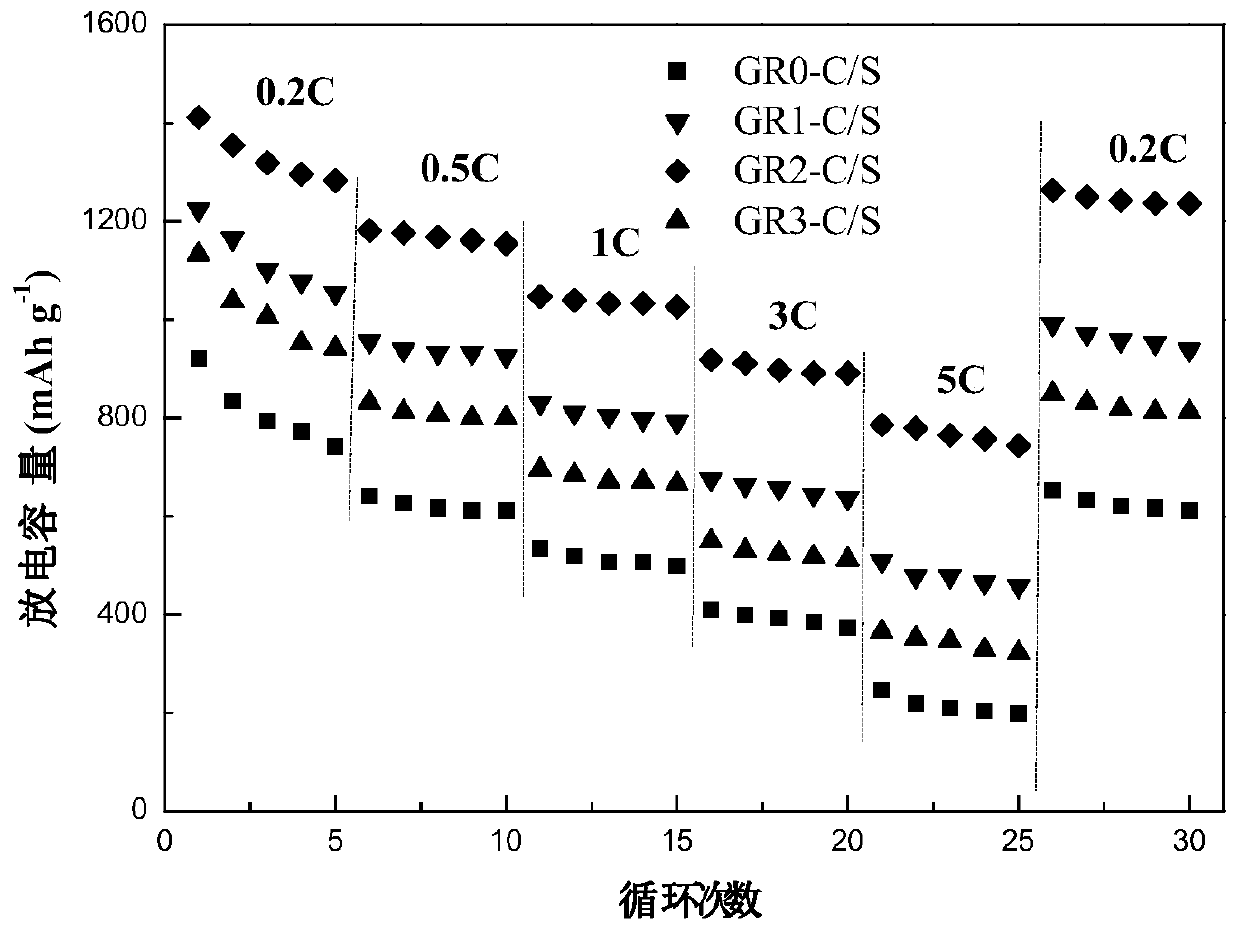Preparation method of graphene/sulfur composite material, and application of graphene/sulfur composite material in lithium-sulfur battery
A composite material and graphene technology, applied in lithium batteries, battery electrodes, non-aqueous electrolyte batteries, etc., can solve the problems affecting the charge-discharge cycle performance of lithium-sulfur batteries, improve the charge-discharge cycle performance, enhance electrode conductivity, Good capacity retention rate
- Summary
- Abstract
- Description
- Claims
- Application Information
AI Technical Summary
Problems solved by technology
Method used
Image
Examples
Embodiment 1
[0030] A preparation method of graphene / sulfur composite material, comprising the following steps:
[0031] (1) Mix formaldehyde and resorcinol according to the molar ratio of 2:1, then add graphene, the molar ratio of graphene and resorcinol is 1:2, and then under the constant temperature environment of 85°C, in the oil bath condition Down, stirring speed 160r / min, react 10h, obtain organogel;
[0032] (2) drying the organogel prepared above in an oven at 100° C. under normal pressure for 24 hours to obtain the organogel;
[0033] (3) Next, the organogel in the above step (2) was heated in a nitrogen atmosphere at 5°C min -1 The heating rate was increased to 850° C., and the carbonization was carried out at a high temperature for 8 hours to obtain a graphene-modified carbon material.
[0034] (4) The graphene-modified carbon material and sublimed sulfur were impregnated at 150° C. for 20 h at a mass ratio of 3:4 to obtain a graphene / sulfur composite material.
Embodiment 2
[0036] A preparation method of graphene / sulfur composite material, comprising the following steps:
[0037] (1) Mix formaldehyde and resorcinol according to the molar ratio of 2:1, then add graphene, the molar ratio of graphene and resorcinol is 1:1, and then under the constant temperature environment of 85 ℃, in the oil bath condition Down, stirring speed 160r / min, react 10h, obtain organogel;
[0038] (2) drying the organogel prepared above in an oven at 100° C. under normal pressure for 24 hours to obtain the organogel;
[0039] (3) Next, the organogel in the above step (2) was heated in a nitrogen atmosphere at 5°C min -1 The heating rate was increased to 850° C., and the carbonization was carried out at a high temperature for 8 hours to obtain a graphene-modified carbon material.
[0040] (4) Immerse the graphene-modified carbon material and sublimed sulfur at a mass ratio of 3:4 at 150°C for 20 hours to obtain a graphene-sulfur composite material, and use the graphene-...
Embodiment 3
[0042] A preparation method of graphene / sulfur composite material, comprising the following steps:
[0043] (1) Mix formaldehyde and resorcinol according to the molar ratio of 2:1, then add graphene, the molar ratio of graphene and resorcinol is 1:1.5, and then in the constant temperature environment of 85°C, in the oil bath condition Down, stirring speed 160r / min, react 10h, obtain organogel;
[0044] (2) drying the organogel prepared above in an oven at 100° C. under normal pressure for 24 hours to obtain the organogel;
[0045] (3) Next, the organogel in the above step (2) was heated in a nitrogen atmosphere at 5°C min -1 The heating rate was increased to 850° C., and the carbonization was carried out at a high temperature for 8 hours to obtain a graphene-modified carbon material.
[0046] (4) Immerse the graphene-modified carbon material and sublimed sulfur at a mass ratio of 3:4 at 150°C for 20 hours to obtain a graphene-sulfur composite material, and use the graphene-s...
PUM
| Property | Measurement | Unit |
|---|---|---|
| First discharge capacity | aaaaa | aaaaa |
Abstract
Description
Claims
Application Information
 Login to View More
Login to View More - R&D
- Intellectual Property
- Life Sciences
- Materials
- Tech Scout
- Unparalleled Data Quality
- Higher Quality Content
- 60% Fewer Hallucinations
Browse by: Latest US Patents, China's latest patents, Technical Efficacy Thesaurus, Application Domain, Technology Topic, Popular Technical Reports.
© 2025 PatSnap. All rights reserved.Legal|Privacy policy|Modern Slavery Act Transparency Statement|Sitemap|About US| Contact US: help@patsnap.com



